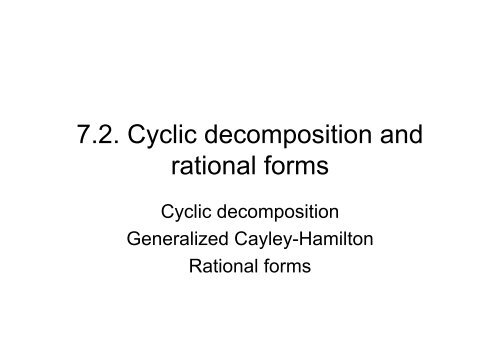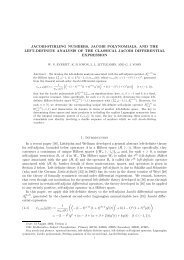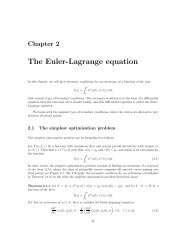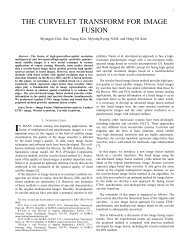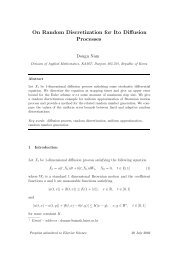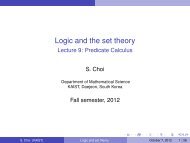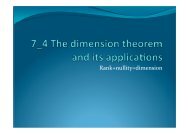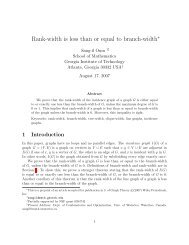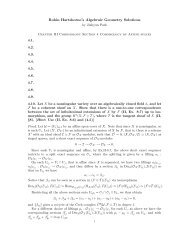7.2. Cyclic decomposition and rational forms
7.2. Cyclic decomposition and rational forms
7.2. Cyclic decomposition and rational forms
Create successful ePaper yourself
Turn your PDF publications into a flip-book with our unique Google optimized e-Paper software.
<strong>7.2.</strong> <strong>Cyclic</strong> <strong>decomposition</strong> <strong>and</strong><br />
<strong>rational</strong> <strong>forms</strong><br />
<strong>Cyclic</strong> <strong>decomposition</strong><br />
Generalized Cayley-Hamilton<br />
Rational <strong>forms</strong>
• We prove existence of vectors a 1 ,..,a r<br />
s.t. V=Z(a 1 ;T)⊕…. ⊕Z(a r ;T).<br />
• If there is a cyclic vector a, then<br />
V=Z(a;T). We are done.<br />
• Definition: T a linear operator on V. W<br />
subspace of V. W is T-admissible if<br />
– (i) W is T-invariant.<br />
– (ii) If f(T)b in W, then there exists c in W s.t.<br />
f(T)b=f(T)c.<br />
(Or f(T)b=f(T)c for all f s.t f(T)b is in W)
• Proposition: If W is T-invariant <strong>and</strong> has<br />
a complementary T-invariant subspace,<br />
then W is T-admissible.<br />
• Proof: V=W ⊕W’. T(W) in W. T(W’) in<br />
W’. b=c+c’, c in W, c’ in W’.<br />
– f(T)b=f(T)c+f(T)c’.<br />
– If f(T)b is in W, then f(T)c’=0 <strong>and</strong> f(T)c is in<br />
W.<br />
– f(T)b=f(T)c for c in W.
• To prove V=Z(a 1 ;T)⊕…. ⊕Z(a r ;T), we<br />
use induction:<br />
• Suppose we have<br />
W j =Z(a 1 ;T)+…+Z(a j ;T) in V.<br />
– Find a j+1 s.t. W j ∩Z(a j+1 ;T)={0}.<br />
• Let W be a T-admissible, proper T-<br />
invariant subspace of V. Let us try to<br />
find a s.t. W∩Z(a;T)={0}.
• Choose b not in W.<br />
• T-conductor ideal is<br />
s(b;W)={g in F[x]|g(T)b in W}<br />
• Let f be the monic generator.<br />
• f(T)b is in W.<br />
• If W is T-admissible, there exists c in W s.t.<br />
f(T)b=f(T)c whenever f(T)b in W.---(*).<br />
• Let a = b-c. b-a is in W.<br />
• Any g in F[x], g(T)b in W g(T)a is in W:<br />
– g(T)a=g(T)(b-c)=g(T)b-g(T)c, g(T)b=g(T)a+g(T)c.
• Thus, S(a;W)=S(b;W).<br />
• f(T)a = 0 by (*) for f the above T-<br />
conductor of b in W.<br />
• g(T)a=0 g(T)a in W for any g in F[x].<br />
– (->) clear.<br />
– (
<strong>Cyclic</strong> <strong>decomposition</strong> theorem<br />
• Theorem 3. T in L(V,V), V n-dim v.s. W 0<br />
proper T-admissible subspace. Then<br />
– there exist nonzero a 1 ,…,a r in V <strong>and</strong><br />
– respective T-annihilators p 1 ,…,p r<br />
– such that (i) V=W 0 ⊕Z(a 1 ;T) ⊕… ⊕Z(a r ;T)<br />
– (ii) p k divides p k-1 , k=2,..,r.<br />
– Furthermore, r, p 1 ,..,p r uniquely determined<br />
by (i),(ii) <strong>and</strong> a i ≠0. (a i are not nec. unique).
• The proof will be not given here. But<br />
uses the Fact.<br />
• One should try to follow it at least once.<br />
• We will learn how to find a i s by<br />
examples.<br />
• After a year or so, the proof might not<br />
seem so hard.
• Corollary. If T is a linear operator on V n ,<br />
then every T-admissible subspace has<br />
a complementary subspace which is<br />
invariant under T.<br />
• Proof: W 0 T-inv. T-admissible. Assume<br />
W 0 is proper.<br />
– Let W 0 ’ be Z(a 1 ;T) ⊕… ⊕Z(a r ;T) from<br />
Theorem 3.<br />
– Then W 0 ’ is T-invariant <strong>and</strong> is<br />
complementary to W 0 .
• Corollary. T linear operator V.<br />
– (a) There exists a in V s.t. T-annihilator of a<br />
=minpoly T.<br />
– (b) T has a cyclic vector minpoly for T agrees<br />
with charpoly T.<br />
• Proof:<br />
– (a) Let W 0 ={0}. Then V=Z(a 1 ;T) ⊕… ⊕Z(a r ;T).<br />
– Since p i all divides p 1 , p 1 (T)(a i )=0 for all i <strong>and</strong> p 1 (T)=0. p 1 is in<br />
Ann(T).<br />
– p 1 is the minimal degree monic poly killing a 1 . Elements of<br />
Ann(T) also kill a 1 .<br />
– p 1 is the minimal degree monic polynomial of Ann(T).<br />
– p 1 is the minimal polynomial of T.
– (b) (->) done before<br />
– (
• Generalized Cayley-Hamilton theorem.<br />
T in L(V,V). Minimal poly p, charpoly f.<br />
– (i) p divides f.<br />
– (ii) p <strong>and</strong> f has the same factors.<br />
– (iii) If p=f 1<br />
r_1<br />
….f k<br />
r_k<br />
, then f= f 1<br />
d_1<br />
….f k<br />
d_k<br />
.<br />
d i = nullity f i (T) r_i /deg f i .<br />
• proof: omit.<br />
• This tells you how to compute r i s<br />
• And hence let you compute the minimal<br />
polynomial.
Rational <strong>forms</strong><br />
• Let B i ={a i ,Ta i ,…,T k_i-1 a i } basis for Z(a i ;T).<br />
• k_i = dim Z(a i ;T)=deg p i =deg Annihilator<br />
of a i .<br />
• Let B={B 1 ,…,B r }.<br />
• [T] B =A= " A 1<br />
0 L 0<br />
$<br />
'<br />
$<br />
0 A 2<br />
L 0<br />
'<br />
$ M M O M '<br />
$<br />
'<br />
# 0 0 L A r &<br />
%
• A i is a k i xk i -companion matrix of B i .<br />
# 0 0<br />
%<br />
%<br />
1 0<br />
% 0 1<br />
% 0 0<br />
A i<br />
= % 0 0<br />
%<br />
% M M<br />
% M M<br />
%<br />
$ 0 0<br />
0 0<br />
0 0<br />
0 0<br />
1 0<br />
0 1<br />
M<br />
M<br />
M<br />
M<br />
0 0<br />
... ...<br />
... ...<br />
... ...<br />
... ...<br />
... ...<br />
0 "c 0<br />
&<br />
(<br />
0 "c 1 (<br />
0 "c 2 (<br />
0 "c 3<br />
(<br />
0 "c (<br />
4<br />
(<br />
M M (<br />
M M (<br />
1 "c<br />
(<br />
k"1 '<br />
• Theorem 5. B nxn matrix over F. Then<br />
!<br />
B is similar to one <strong>and</strong> only one matrix<br />
in a <strong>rational</strong> form.<br />
• Proof: Omit.<br />
O<br />
O<br />
... ...
• The char.polyT<br />
=char.polyA 1 ….char.polyA r<br />
=p 1 …p r .:<br />
– char.polyA i =p i .<br />
• This follows since on Z(a i ;T), there is a cyclic<br />
vector a i , <strong>and</strong> thus char.polyT i =minpolyT i =p i .<br />
• p i is said to be an invariant factor.<br />
• Note charpolyT/minpolyT=p 2 …p r .<br />
• The computations of the invariant<br />
factors will be the subject of Section<br />
7.4.
Examples<br />
• Example 2: V 2-dim.v.s. over F. T:V->V<br />
linear operator. The possible cyclic<br />
subspace <strong>decomposition</strong>s:<br />
– Case (i) minpoly p for T has degree 2.<br />
• Minpoly p=charpoly f <strong>and</strong> T has a cyclic vector.<br />
• If p=x 2 +c 1 x+c 0 . Then the companion matrix is of<br />
the form:<br />
# 0 "c & 0<br />
%<br />
$<br />
1 "c 1<br />
(<br />
'
– (ii) minpoly p for T has degree 1. i.e., T=cI.<br />
for c a constant.<br />
– Then there exists a1 <strong>and</strong> a2 in V s.t.<br />
V=Z(a 1 ;T)⊕Z(a 2 ;T). 1-dimensional spaces.<br />
– p 1 , p 2 T-annihilators of a 1 <strong>and</strong> a 2 of degree<br />
1.<br />
– Since p 2 divides the minimal poly p 1 =(x-c),<br />
p 2 =x-c also.<br />
– This is a diagonalizable case.<br />
" c 0%<br />
$<br />
# 0<br />
'<br />
c&
• Example 3: T:R 3 ->R 3 linear operator<br />
# 5 "6 "6&<br />
given by % ( in the st<strong>and</strong>ard<br />
A =<br />
%<br />
"1 4 2<br />
(<br />
basis. % 3 "6 "4(<br />
– charpolyT=f=(x-1)(x-2) 2<br />
– minpolyT=p=(x-1)(x-2) !<br />
(computed earlier)<br />
– Since f=pp 2 , p 2 =(x-2).<br />
$<br />
'<br />
– There exists a 1 in V s.t. T-annihilator of a 1<br />
is p <strong>and</strong> generate a cyclic space of dim 2<br />
<strong>and</strong> there exists a 2 s.t. T-annihilator of a 2 is<br />
(x-2) <strong>and</strong> has a cyclic space of dim 1.
• The matrix A is similar to B=<br />
(using companion matrices)<br />
# 0 "2 0&<br />
% (<br />
%<br />
1 3 0<br />
(<br />
$ % 0 0 2'<br />
(<br />
• Question How to find a 1 <strong>and</strong> a 2 <br />
– In general, almost all vector will be a 1 . (actually<br />
choose s.t deg s(a 1 ;W) is maximal.)<br />
– Let e 1 =(1,0,0). Then Te<br />
!<br />
1 =(5,-1,3) is not in the span<br />
.<br />
– Thus, Z(e 1 ;T) has dim 2<br />
={a(1,0,0)+b(5,-1,3)|a,b in R}={(a+5b,-b,3b)|a,b, in<br />
R} ={(x 1 ,x 2 ,x 3 )|x 3 =-3x 2 }.<br />
– Z(a 2 :T) is null(T-2I) since p 2 =(x-2) <strong>and</strong> has dim 1.<br />
– Let a 2 =(2,1,0) an eigenvector.
• Now we use basis (e 1 ,Te 1 ,a 2 ). Then the<br />
change of basis matrix is S= # 1 5 2&<br />
• Then B=S -1 AS.<br />
% (<br />
%<br />
0 "1 1<br />
(<br />
$ % 0 3 0'<br />
(<br />
• Example 4: T diagonalizable ! V->V with<br />
char.values c 1 ,c 2 ,c 3 . V=V 1 ⊕V 2 ⊕V 3 .<br />
Suppose dim V 1 =1, dimV 2 =2, dimV 3 =3.<br />
Then char f=(x-c 1 )(x-c 2 ) 2 (x-c 3 ) 3 .<br />
Let us find a cyclic <strong>decomposition</strong> for T.
• Let a in V. Then a = b 1 +b 2 +b 3 . Tb i =c i b i .<br />
• f(T)a=f(c 1 )b 1 +f(c 2 )b 2 +f(c 3 )b 3 .<br />
• By Lagrange theorem for any (t 1 ,t 2 ,t 3 ), There<br />
is a polynomial f s.t. f(c i )=t i ,i=1,2,3.<br />
• Thus Z(a;T) = .<br />
• f(T)a=0 f(c i )b i =0 for i=1,2,3.<br />
• f(c i )=0 for all i s.t. b i ≠0.<br />
• Thus, Ann(a)=<br />
$<br />
b i #0<br />
(x " c i<br />
)<br />
• Let B={b 1 1,b 2 1,b 2 2,b 3 1,b 3 2,b 3 3}.<br />
!
• Define a 1 = b 1 1+b 2 1+b 3 1. a 2 =b 2 2+b 3 2,<br />
a 3 =b 3 3.<br />
• Z(a 1 ;T)=< b 1 1,b 2 1,b 3 1><br />
p 1 =(x-c 1 )(x-c 2 )(x-c 3 ).<br />
• Z(a 2 ;T)=< b 2 2,b 3 2 >, p 2 =(x-c 2 )(x-c 3 ).<br />
• Z(a 3 ;T)= , p 3 =(x-c 3 ).<br />
• V= Z(a 1 ;T)⊕Z(a 2 ;T)⊕Z(a 3 ;T)
• Another example T diagonalizable.<br />
• F=(x-1) 3 (x-2) 4 (x-3) 5 . d 1 =3,d 2 =4,d 3 =5.<br />
• Basis<br />
• Define<br />
!<br />
{b 1 1 ,b 2 1 ,b 3 1 ,b 1 2 ,b 2 2 ,b 3 2 b 4 2 ,b 1 3 ,b 2 3 ,b 3 3 ,b 4 3 ,b 5 3 }<br />
a j<br />
:=<br />
#<br />
i<br />
b j<br />
d i " j<br />
• Then Z(a j ;T)= d i ≥j. <strong>and</strong><br />
• T-ann(a j )=p j = $ (x " c<br />
!<br />
i<br />
)<br />
d i # j<br />
• V= Z(a 1 ;T)⊕Z(a 2 ;T) ⊕…⊕Z(a 5 ;T)<br />
!
a 1<br />
= b 1 1<br />
+ b 2 3<br />
1<br />
+ b 1<br />
a 2<br />
= b 1 2<br />
+ b 2 3<br />
2<br />
+ b 2<br />
a 3<br />
= b 1 3<br />
+ b 2 3<br />
3<br />
+ b 3<br />
a 4<br />
= b 2 3<br />
4<br />
+ b 5<br />
3<br />
a 5<br />
= b 5<br />
!


